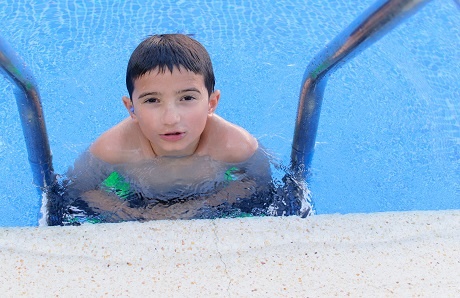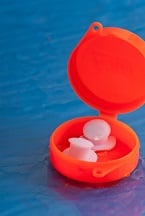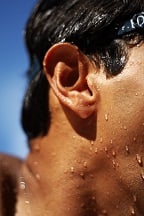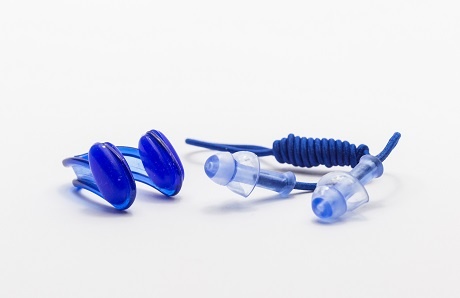—Comparing earplug materials and choices to achieve the best fit and most effective protection

Guest blog: Alex Pop, Say What Hearing
You protect your eyes when swimming by wearing goggles, so why not protect your ears with earplugs?
If you spend much time in a swimming pool or the ocean, your best bet is to use earplugs to guard against swimmer’s ear, surfer’s ear, and other ear infections. This guide will help you will find the right pair of earplugs to fit your ears and your swimming needs.
Swimming is an excellent way to have fun, stay in shape, and for some it fulfills their competitive spirit. However, many fans of the water will at some time experience the irritating post-swim sensation of water trapped inside their ear canal.
The all-too-familiar feeling of unwanted water sloshing inside your ears is not just annoying, it’s potentially dangerous. If you frequently enjoy the swimming, and water makes its way into your ears, problems can develop.
Excess moisture in your ear canal creates a more-welcoming environment for bacteria and fungi to breed. A condition called acute otitis externa—better-known as “swimmers can”—can take hold. When it does, the outer ear becomes infected, irritated, and inflamed. Ouch!
And although the water in a chlorinated pool is filtered, cleaned, and free from most dangerous microbes, even chlorine can’t kill every kind of unwanted organism. Precaution never hurt anyone, so consider using swim earplugs.
A quality pair provides an affordable, convenient defense against water contaminants that could cause infection or make an existing one worse and protect ears—especially those of children.
Swim earplug basics
Earplugs are made of specific materials so you can insert them into your ear to buffer sound or provide a barrier to water. They are typically manufactured using wax, foam, rubber, plastic, and silicone.
Best Earplug Size
Size matters. When it comes to earplugs, don’t overlook this factor, as the right size helps ensure the best possible fit.
For women and children, be advised: Most earplugs are sized for men. The standard earplug sizes are small, medium, and large. If you are female or buying earplugs for a child, the best choice will almost always be a small size.
Variety of Choice
Even though their job is relatively straight-forward—keep water out of the ear canal—the solutions vary greatly in effect and cost. And not all earplugs are created equal.
First and first most, know that not all earplugs are designed for the water. You want to seek models that are specially made with watertight, yet pliable, materials. After all, the goal is to help keep your ear canal dry, so you need earplugs designed for waterborne activities.


Different kinds of swim earplugs
Foam
Foam earplugs, most commonly seen in bright orange, are designed for noise suppression. They cost just a few dollars, and they work well if you frequent loud concerts or work at a construction site.
However, they are not designed for keeping water out of your inner ear; the foam material does not provide an adequate barrier against penetration from incoming water. Many parents make the mistake of buying foam earplugs for their little swimmers. Don’t. Never use foam earplugs for the water.
Conical
Conical, or flanged, earplugs typically look like a tiny cone with graduated bands on the outer edges. They are made from plastic, and each band is wider than the next—creating a two-, three-, or even four-tiered barrier, making it tough for water to get through. Made out of a flexible rubber or plastic, you insert them into your ear as deep as they will go to the point of comfort.
The flanges act independently to seal in the ear canal. These models typically cost less than their silicon or custom counterparts, and they are very reliable in the water. For these reasons, conical earplugs are an excellent choice if you are new to swimming and are not ready to spend more for a set of silicone earplugs (see next section).
However, a word of caution: Conical earplugs typically come with long stems that extend away from the ears—like a pair of antennae. Longer stems may get in the way of your swim cap, and if your goal is a cap with a watertight barrier over your earplugs—for the least amount of resistance—this kind of earplugs may not be your best bet. Those with long stems may prevent you from pulling the swim cap completely over your ears.
Silicone
Silicone earplugs resemble silly putty in that you can reshape and remold them over and over. With their soft, malleable material, you can achieve a great fit. You can mold the silicone to fit directly into your ear canal, contouring it to its unique shape.
Because the earplugs provide a custom fit, many swimmers report that it’s their pick as the most comfortable type. For intermediate to advanced swimmers, silicone represents a step up from plastic conical earplugs, both in performance and in price.
Silicone is washable, and it’s more durable than plastic. Medical-grade, pre-molded silicone (used in many custom earplugs; see below) provide an effective seal against water.
One minor drawback: When not in use—if not properly stored—silicone’s sticky texture can attract unwanted substances like hair, lint, and dust. Once this happens, they are difficult to clean and may need replacing.
Custom
How about an earplug that’s been made just for you? Customized earplugs can be purchased from an audiologist, healthcare professional, or ear-nose-throat physician. They are made of memory foam or polyurethane.
For the polyurethane kind, a mold is taken of your ear so that the plug will fit snugly. For the best fit, you can have your professional take the mold. Another option is to purchase a do-it-yourself kit and take the mold yourself. Before insertion, the material is heated so it conforms perfectly to the contours of each ear. Later, the material hardens into the customized shape.
Top custom earplugs allow for reheating the material and reshaping it if you didn’t get it right the first time. As a side benefit, these custom versions may also be used for sound dampening, meaning you can go to the afternoon concert before your hair has dried off from a morning swim at the pool!
The perfect fit does come at a higher price. Typically, tailor-made models run from $5 to $250 a pair.
Bonus tip: Many custom earplugs are marketed as being water repellant but have let down many a seasoned swimmer. Exasperated after time-consuming customizing (and re-customizing) many swimmers opt for a pair of reliable and non-complicated conical or silicate earplugs instead. Be sure to check on the packaging or with your audiologist to confirm if the custom earplugs are good for pool use.
Corded vs. uncorded
Corded earplugs are connected by a cord; usually, the cord is made of a water-friendly material. For swimmers, this feature can be particularly helpful, as it prevents you from losing the earplugs in the pool.
However, a pair of cored earplugs may not be as comfortable to wear. The cord may also get in the way of your swimmer’s cap. Competitive swimmers should opt for a smaller, more discreet, uncorded variety of earplugs. That way, the earplugs and cord do not add as much resistance when stroking in the pool.

Best practices for using earplugs
- Keep earplugs in their carrying case. Many competitive-swimmer earplugs come with a case that’s waterproof.
- For better placement, put earplugs in before getting your ears wet.
- Keep earplugs away from toddlers who could mistake them for candy.
- If you wear a swim cap, try it on to make sure the earplugs work well with it.
Earplug lifespan
Consider the lifespan of the earplugs. Some are good only for as few as five uses. More times than that, and the material may darken and lose its stickiness or pliability.
Water, molding, and sun damage can also adversely affect the life of the product. Once you see the earplugs get crusty or the plastic becoming dry (almost like paint chipping) from too much sun exposure, parts of the earplug start to come off. In this case, it’s best to break out a fresh pair.
Block the water—not the sound
Swim earplugs are designed to create a water-tight seal in your ear canal. When inserting any material that blocks water, it will—by default—also block some sound.
So consider: Do you still need to hear well while swimming? Are you a competitive swimmer who needs to hear your coach’s instructions? If the earplugs are for your child, do you want him or her to be able to hear your words of encouragement?
If so, conical earplugs may be the ones to buy. You can also check the noise-reduction rating (NRR) of the earplugs, and opt for the ones that block the least amount of sound. They are suitable for water sports where users need protection from the water but still need to hear voices well.
Choosing swim earplugs that are right for you
The best way to use earplugs is to consider the behavior or activity for which you will use them. This includes swimming, as well as sleeping, working, hunting, attending loud concerts, or even deep-sea diving.
A leak-proof seal is never guaranteed; all earplugs will—inevitably— allow some water to enter. However, by choosing the right kind of earplug for your needs and following the best practices outlined here, you will be well on your way to keeping your ear canals dry, avoiding infection, and having one less thing to worry about as you race to the finish line.




.jpg?width=1490&name=rock-waterfall-slide-pool%20(1).jpg)